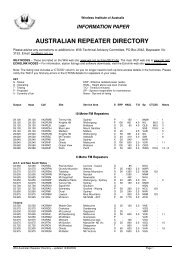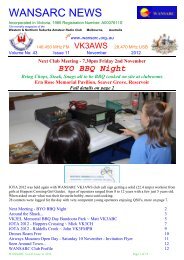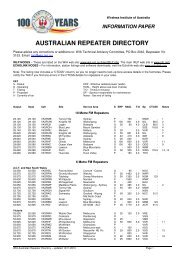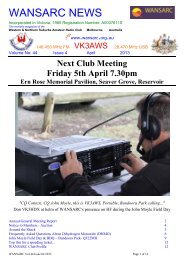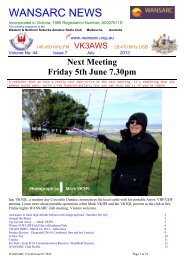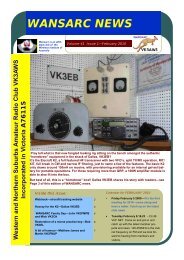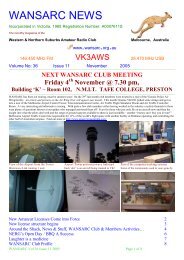August - Western & Northern Suburbs Amateur Radio Club
August - Western & Northern Suburbs Amateur Radio Club
August - Western & Northern Suburbs Amateur Radio Club
You also want an ePaper? Increase the reach of your titles
YUMPU automatically turns print PDFs into web optimized ePapers that Google loves.
Electronic Resellers Association International (ERAI), a group that represents more than 1000 independent distributors, has beenworking to improve quality control among its members by, for example, setting up an escrow service, which allows buyers to inspectthe goods before completing their purchase, and by launching its own Web-based database, Parthunter.com, for locating parts. Unlikeother online trading sites, Parthunter vets its traders and alerts users when they search for a part that is known to have beencounterfeited in the past. Such activities are encouraging signs, but the fact remains that most independent distributors don't subjectthemselves to the kind of scrutiny that ERAI demands of its members.With no systematic way to defeat counterfeiting, individual companies have been fending for themselves. One of the chief defences isto rigorously monitor the supply chain. The large computer company mentioned earlier has a policy of avoiding independent partsbrokers; it tries to purchase parts directly from trusted sources--and hopes that its suppliers also purchase directly from trustedsources. Big companies that do all or part of their manufacturing in China and other parts of Asia also make efforts to police theiroperations there, often maintaining full-time staff or hiring outside services to look out for bogus parts.Identifying suspected counterfeiters is another approach. Underwriters Laboratories Inc., in Northbrook, Ill., is particularly aggressivein this area. UL is not a manufacturer but is hired by manufacturers to test and certify their products. So when a counterfeiter uses afake UL logo to lend an air of authenticity to an otherwise bogus product, UL understandably grows concerned. During the last 10years, the company's dedicated anticounterfeiting team has worked with U.S. Customs and Border Protection, the Federal Bureau ofInvestigation, and other agencies around the world to identify and seize millions of products bearing counterfeit UL marks.The merchandise seized has included not only computer components and power supplies but also lamps, extension cords, Christmaslights, fans, telephones, and radios.UL also has introduced holographic labels that it says are virtually impossible to forge. Indeed, the use of sophisticated holograms orother labelling is another way that companies attempt to thwart counterfeits. For instance, the router and networking company 3ComCorp., Marlborough, Mass., announced in January that it had begun using three-dimensional, tamper-foiling holographic labels on allits switches. But as anyone who has purchased pirated goods in China and elsewhere can attest, genuine-looking hologram labels arecheap and plentiful; even if they only approximate a real logo, the holograms lend that air of authenticity.Like many companies, 3Com also regularly posts notices on its Web site on how to identify legitimate company products. But with somany manufacturers and suppliers employing their own authenticating schemes, there is simply no way to keep up with theinformation. Who has time to check that the laser-etched serial number on a particular memory device is exactly as the chip makersays it should be? In one telling example, the outward appearance of a counterfeit lithium-ion battery for a Nikon digital cameradiffered from the real thing only in the subtly squarer shape of one of hundreds of Japanese characters on its label.Manufacturers big and small need to be doing more to ensure that the parts and modules contained within their systems are legitimate.This is particularly true for critical systems that have a safety or security function. Among the schemes proposed so far are speciallydesigned tests of individual components and finished products and aggressive identification methods to verify a component's sourceand type.Here's another recurring idea: create a licensing procedure for introducing parts into a given industry's supply chain. Anyone lackingthe license cannot sell into that supply chain. Unfortunately, the huge number of suppliers that most companies deal with today hasdeterred them from trying to implement such a scheme. In fact, in 1995, following numerous incidents of substandard componentsmaking their way into aircraft, the U.S. Federal Aviation Administration considered licensing avionics parts but rejected the idea.In any case, any company that is willing to risk financial penalties and even jail terms to sell counterfeits is unlikely to be dissuadedby administrative checks or licensing requirements.<strong>Radio</strong>-frequency identification (RFID) tags have been highly touted as a means of tracing a product's path as it zigzags through thesupply chain. The wirelessly readable RFID labels, which can encode authenticating data such as where and when the part was madeand by whom, are more informative and much harder to fake than simple bar codes, and most can be scanned from a distance, savingtime and effort. The smallest RFID, Hitachi's micro-chip, measures just 0.3 millimetres on a side, which in theory would be tinyenough to embed in many small components. But use of RFIDs demands that companies agree on a standard encoding scheme; todate that hasn't happened.A similar approach is to embed in each component software or firmware identifiers, including serial numbers, manufacture date,application code, and country of origin. After a number of fake lithium-ion batteries in digital and video cameras exploded, Nikonexperimented with embedding software in two Coolpix digital camera models sold in Japan. Details about the technology are scant,but the software reportedly read an ID number on the lithium-ion battery to confirm its authenticity and to prevent non-Nikonbatteries from being used in the camera. Such an approach, while effective, might not be popular with consumers--who probably wantthe option of using other makes of battery--or with authorities worried about anticompetitive practices.Electronics companies also are exploring technologies for identifying the resins, adhesives, and other chemicals used by the industry.Microtrace Inc., based in Minneapolis, markets a technique for tracing explosives after they have detonated. When encodednanoparticles are mixed into a resin, the data in the "microtaggants" can be read using handheld scanners, enabling the manufacturerto verify the resin's source. Whether such a scheme would work for all kinds of electronics materials, which often need to beextremely pure, isn't yet known.The other downside to all such safeguards is cost. Incorporating anticounterfeiting technology into a high-value IC or a printed-circuitboard could add at least 10 percent to the cost--too high a price for most companies, even if it means preventing the counterfeiting.And for components that sell for mere pennies, embedding even a low-cost RFID tag would be prohibitive.In short, there is no silver bullet when it comes to defeating counterfeiters. What is really needed is a constant multifaceted approach.Governments everywhere need to beef up their IP laws and, more important, enforce them. Industry representatives need to worktogether to adopt standard practices for monitoring supply chains. And companies need not only to acknowledge the extent of theproblem but to take deliberate steps--some of which are bound to be costly--to root out bogus parts from their manufacturing lines.Whenever a company falls down on the job or authorities fail to police the problem, it simply creates an opening for counterfeiters.If the goal is keep bogus products out of consumers' hands, clearly everyone needs to do more.~Michael Pecht, an IEEE Fellow, Electronic Products and Systems Centre at the University of Maryland ©WANSARC Vol 43 Issue 08 2012 Page 11 of 20



